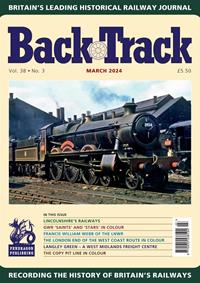|
|
Contents Listing - Articles & Features in this issue
Colourful Salisbury
The Saga of Charing Cross Station Roof 1905-1906...
Modernising the North Eastern Region: Trackwork and Signalling
let's Go Glasgow Electric' - Part Two
The Train Ferries - Part One
The Origins Diagnosis and Historical Prevention of Track Failures - Part One
Night Must Fall
To Hull
51 Years of Western Express Running
Down South
Charles Clare 1832-1882
Tickets of Joint Railways
Clearing the Air
Christ's Hospital Station: The LBSCR's 'White Elephant'
North British Six-Coupled
A Lincolnshire Signalman
Readers' Forum
Book Reviews
Cover - The late show at Preston - only a few more days of steam to go as LMS Class 5 4-6-0 No.44806 assembles an evening parcels train on 26th July 1968.
Article Snippets
Going over old ground:
The railway history of the 1960s and 70s was, I suppose, noted as much as anything for a long and depressing programme of line closures as economies were sought by the riddance of underused services and stations. The litany of farewell specials and packed 'last train' rituals prompted cynical observations from railwaymen that if as many people had used the line on a regular basis it wouldn't now be closing and of course there was some uncomfortable truth in that; which of us hasn't felt a tinge of guilt as we took part in communal lamentations for the passing of a favourite line on which we travelled only occasionally? I dare say, as we waved away the final train and sorrowed for the loss of what seemed an old friend, that we would not have imagined that the 1990s and beyond would be witnessing railway reopenings - and yet so it has come to be. Not just were old stations disinterred and new ones built (at costs for which you'd expect an overall roof, refreshment room and resident station master), reflecting social changes such as population growth and 'park and ride' trends, but entire lines have had their passenger services returned to them. The 'Robin Hood Line' between Nottingham and Worksop (in stages during the 1990s) and the Ebbw Vale branch (in 2008) are a couple which spring to mind, while the highest-profile case is perhaps the section of the Waverley Route between Edinburgh and Tweedbank (now presented as the 'Borders Line') which (with others in Scotland) has had to be exhumed from the brambles and buddleia of years of abandonment and be completely rebuilt.
The Waverley Route's partial reopening last year was ceremonially performed by HMThe Queen and I look forward to taking my first ever journey over any part of that famed railway. Another length of closed railway was revived this year, one a fraction of the length of the Borders scheme (measured in yards rather than miles!), its inaugural train flagged away by no royal personage: the Todmorden curve once again links the Calder Valley main line westwards on to the Copy Pit route from Todmorden to Burnley. This restores the triangular layout within which used to wait, until the very end of steam, the banking engines called to assist heavy coal trains up the 1 in 65 towards Copy Pit Summit. A new service is now possible between Manchester and Burnley, so during August I availed myself of a new little bit of mileage. It's a cracking run from Manchester Victoria via Rochdale, Summit Tunnel, Todmorden and Copy Pit: some grandly rugged Pennine scenery and some good industrial archaeology in Burnley's 'Weavers' Triangle' with a well-stocked pub for lunchtime necessities. Many are the benefits to be gained from reopening old railways - whether long or short!
I mentioned the Queen declaring the 'Borders Line' open for business, having done which she boarded a special formed not of the official Royal Train carriages but a set of Mkls from a charter operator in which she and the Duke had a first class compartment 'poshed-up' for them. Seeing on the television news that into this there sidled a political leader who took up a spare seat, it occurred to me that perhaps HM and HRH, being unfamiliar with 'ordinary' carriages, had not been briefed on the tactics traditionally employed to discourage intruders from sliding the corridor door open and enquiring "Is that seat free?" - spreading yourself about, placing coats and bags on the unoccupied seats, having some broadsheet newspapers to read and strew around, scowling ferociously, in the hope that anyone looking for somewhere to sit would be persuaded to keep moving and try a compartment further along. Gone the days when you could stalk the corridors of a nice long train in search of an empty compartment of which to seize occupancy and defend it. Another politician was more recently in the headlines bemoaning his inability to find a seat on an East Coast route train and consequently having to squat on the floor in a vestibule end. As is often the case in such 'incidents', all was not quite as it seemed since he apparently eschewed several single seats in pursuit of two together so he could sit with his wife.
Unless they had decided to travel on a sudden whim, the situation shouldn't have been any great surprise; seasoned campaigners (many unseasoned ones as well) know to book in advance and obtain seat reservations. Even then, if you leave it late, procuring two together can't be assured and if you go 'on spec', having to split up is often to be expected. An author last month commented on the entrepreneur who intended to make rail travel an experience equal to that of travelling by aeroplane (as if that is enjoyable!) - and that unfortunately he succeeded. The proliferation of 'airline'-style seating in rows of two over the last few decades (supposedly in response to 'public demand' but most likely to prise more seats into the available space) has meant that rarely can more than two people at most can sit together and larger groups or families can rarely manage to gather companionably around one of the few remaining tables. In the Great Western Railway 1902 public timetable the company advertised that "Upon giving a day's notice Compartments can be reserved for distances over 20 miles upon payment of not less than four First Class or six Second or Third Class full fares..." The Midland could do even better, requiring only two hours' notice at a terminal station where the train started; compartments could also be 'engaged' for ladies only. I recalled having read something like this when I was obliged to crouch on the floor of a Grand Central train between York and London (see Editorial 26/1) without even the company of a slumped politician on whom to vent my spleen, or when standing in a 'Voyager' early this year. And as for the next one to say things will get better...
The railway history of the 1960s and 70s was, I suppose, noted as much as anything for a long and depressing programme of line closures as economies were sought by the riddance of underused services and stations. The litany of farewell specials and packed 'last train' rituals prompted cynical observations from railwaymen that if as many people had used the line on a regular basis it wouldn't now be closing and of course there was some uncomfortable truth in that; which of us hasn't felt a tinge of guilt as we took part in communal lamentations for the passing of a favourite line on which we travelled only occasionally? I dare say, as we waved away the final train and sorrowed for the loss of what seemed an old friend, that we would not have imagined that the 1990s and beyond would be witnessing railway reopenings - and yet so it has come to be. Not just were old stations disinterred and new ones built (at costs for which you'd expect an overall roof, refreshment room and resident station master), reflecting social changes such as population growth and 'park and ride' trends, but entire lines have had their passenger services returned to them. The 'Robin Hood Line' between Nottingham and Worksop (in stages during the 1990s) and the Ebbw Vale branch (in 2008) are a couple which spring to mind, while the highest-profile case is perhaps the section of the Waverley Route between Edinburgh and Tweedbank (now presented as the 'Borders Line') which (with others in Scotland) has had to be exhumed from the brambles and buddleia of years of abandonment and be completely rebuilt.
The Waverley Route's partial reopening last year was ceremonially performed by HMThe Queen and I look forward to taking my first ever journey over any part of that famed railway. Another length of closed railway was revived this year, one a fraction of the length of the Borders scheme (measured in yards rather than miles!), its inaugural train flagged away by no royal personage: the Todmorden curve once again links the Calder Valley main line westwards on to the Copy Pit route from Todmorden to Burnley. This restores the triangular layout within which used to wait, until the very end of steam, the banking engines called to assist heavy coal trains up the 1 in 65 towards Copy Pit Summit. A new service is now possible between Manchester and Burnley, so during August I availed myself of a new little bit of mileage. It's a cracking run from Manchester Victoria via Rochdale, Summit Tunnel, Todmorden and Copy Pit: some grandly rugged Pennine scenery and some good industrial archaeology in Burnley's 'Weavers' Triangle' with a well-stocked pub for lunchtime necessities. Many are the benefits to be gained from reopening old railways - whether long or short!
I mentioned the Queen declaring the 'Borders Line' open for business, having done which she boarded a special formed not of the official Royal Train carriages but a set of Mkls from a charter operator in which she and the Duke had a first class compartment 'poshed-up' for them. Seeing on the television news that into this there sidled a political leader who took up a spare seat, it occurred to me that perhaps HM and HRH, being unfamiliar with 'ordinary' carriages, had not been briefed on the tactics traditionally employed to discourage intruders from sliding the corridor door open and enquiring "Is that seat free?" - spreading yourself about, placing coats and bags on the unoccupied seats, having some broadsheet newspapers to read and strew around, scowling ferociously, in the hope that anyone looking for somewhere to sit would be persuaded to keep moving and try a compartment further along. Gone the days when you could stalk the corridors of a nice long train in search of an empty compartment of which to seize occupancy and defend it. Another politician was more recently in the headlines bemoaning his inability to find a seat on an East Coast route train and consequently having to squat on the floor in a vestibule end. As is often the case in such 'incidents', all was not quite as it seemed since he apparently eschewed several single seats in pursuit of two together so he could sit with his wife.
Unless they had decided to travel on a sudden whim, the situation shouldn't have been any great surprise; seasoned campaigners (many unseasoned ones as well) know to book in advance and obtain seat reservations. Even then, if you leave it late, procuring two together can't be assured and if you go 'on spec', having to split up is often to be expected. An author last month commented on the entrepreneur who intended to make rail travel an experience equal to that of travelling by aeroplane (as if that is enjoyable!) - and that unfortunately he succeeded. The proliferation of 'airline'-style seating in rows of two over the last few decades (supposedly in response to 'public demand' but most likely to prise more seats into the available space) has meant that rarely can more than two people at most can sit together and larger groups or families can rarely manage to gather companionably around one of the few remaining tables. In the Great Western Railway 1902 public timetable the company advertised that "Upon giving a day's notice Compartments can be reserved for distances over 20 miles upon payment of not less than four First Class or six Second or Third Class full fares..." The Midland could do even better, requiring only two hours' notice at a terminal station where the train started; compartments could also be 'engaged' for ladies only. I recalled having read something like this when I was obliged to crouch on the floor of a Grand Central train between York and London (see Editorial 26/1) without even the company of a slumped politician on whom to vent my spleen, or when standing in a 'Voyager' early this year. And as for the next one to say things will get better...
Adverts and Links based on this content
Advertisement




